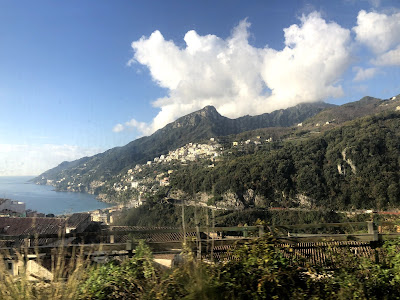Zooming up the Amalfi coast, I was in Pompeii by 10.
I tried preparing for Pompeii—you can read hundreds of pages of intricate diagrams or download a podcast by Rick Steves—but as with Rome, found it overwhelming. So instead, I just wandered.
I would have picked up an audioguide or even a better brochures, but I wound up at a side entrance. It was fine. I barely went to any of the places on Mary Beard's list. Really, that's fine.The basics: Pompeii had existed in this location by the sea for centuries; the Roman town was built in 37 to 27 BC.
In 62 AD, a big earthquake caused some damage, and then in 79 AD with only a little warning, nearby Mt Vesuvius erupted, covering the area in ash. Perhaps 20,000 were living there at the time.
Pompeii Scavi is an enormous site. It was rediscovered in the 16th century, but the most serious excavation happened beginning in 1858under the direction of Giuseppi Fiorelli.
If you visited Pompeii as a college student, you should go back and see how much more has been restored, now with better tools and techniques. (I had the same realization recently with Teotihuacan.)The beauty of visiting Italia in December is there aren't any crowds, just a handful of tour groups and some families taking awful posed shots. So I was truly able to explore Pompeii at my own pace,
There's so much to see when you're not in a hurry. This centaur is a thing of beauty.
The visitor center has movies showing a possible reconstruction.
You have a lot of freedom as far as which roads and houses to explore. Nothing stops you from touching the marble.
There are quite a few pretty mosaics, although I heard a guide say some of them are replicas.
The originals are at the Naples Archaeological museum, where I'm going tomorrow, right after I eat some Neapolitan pizza.
These bricks lie under the plaster of the pillars. I had no idea.
A lot of pillars are in scaffolding that resembles an external cast.
This warrior looks out toward the town of Pompei.
Inside the visitors center, they had an exhibit including cracked objects buried as a sacrifice.
In the Temple of Apollo, we find...Artemis, representing the moon.
And directly across from her is Apollo.
I admired his beautiful feet and arches. Apparently many people have rubbed them over the ages.
One of the most famous things at Pompeii is the casts made from people who perished there. This workshop is reassembling pots and gathering coins.
Not a sculpture--a terrified human being.
The original LEGOs
The park is separated into ten sections, each representing a "neighborhood." The rich people had bigger estates and lived up the hill. Just like today.
Vesuvius is still visible in the distance.
A few more mosaics, at the entrance to the house.
One of my favorite houses had this secret garden.
Was this his house?Uncovering the layers of materials
Rose is a rose is a rose.
Brightly colored tile
A tiny status dancing in the fountain.
More casts of people who perished.
This would be at home in the southwest. Note the intricate herringbone pattern.
One of several amphitheaters. This is a small one.
A few brightly painted houses
Elaborate gold leaf
The colored washes give each home a different look.
This was my favorite room. Owned by a very rich man.
Last stop was the amphitheater, which predates the colosseum in Rome by 100 years. They had a Pink Floyd exhibit.
As you might imagine, I'm all worn out from walking miles and miles (20,000 steps) on cobblestones. But not so worn out that I won't tell you about my splurgy lunch in a separate post.
Pompeii was the place I most wanted to explore on this trip. Every day has been filled with new wonders. But Pompeii does not disappoint.










































No comments:
Post a Comment